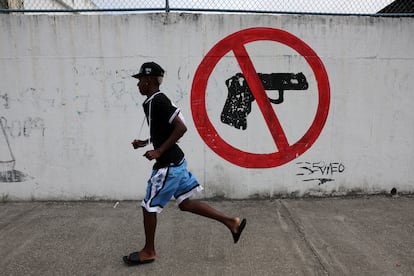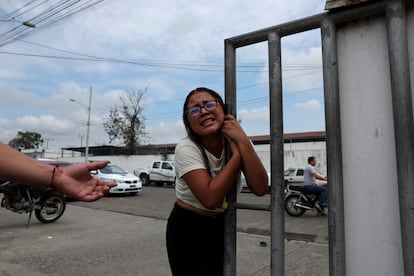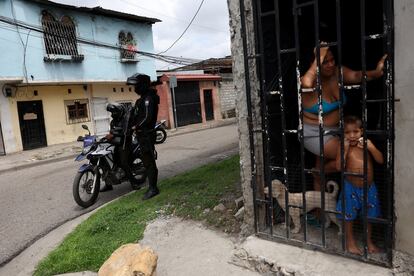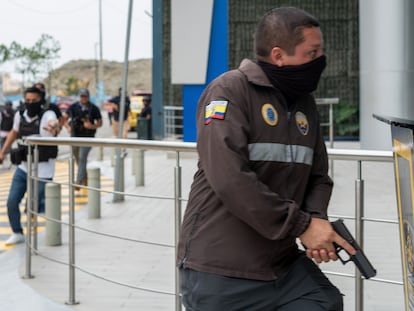Violence in Ecuador: a new, long-standing problem
The country’s crime rate has rocketed, but the problems of drug trafficking and gang violence have been brewing since the 1980s


The wave of violence that Ecuador has suffered in recent days might be interpreted as a new phenomenon in a country that until now had been on the margins of the serious issues with criminality in neighboring nations, such as Peru and Colombia. But those days are gone. In the last three years there have been prison riots with dozens of people killed, an assault with dynamite, hostages held at gunpoint on live public television, bombs in barracks and police stations, and selective assassinations of politicians and presidential candidates. Drug trafficking has quietly emerged as a parallel power to the state that controls judges, generals, and police officers. One might think that the breakdown of the institutions has taken place in record time. However, a look at the last 40 years shows that the problems that have now emerged have been brewing since the 1980s, when large-scale drug trafficking began and the first gangs were created.
“Ecuador as an island of peace is a misnomer,” explains Daniel Pontón, a security analyst and university professor at Ecuador’s Institute of Higher National Studies. Unlike Colombia, the country had no guerrillas. The government crushed some timid attempts, but from the 1980s onwards the homicide rate began to rise. At that time, Pontón says, the presence of Mexican drug cartels was officially recorded, but was kept secret until now. Problems on the border intensified with the presence of FARC and Colombian paramilitary groups on the other side. To combat these threats, the state authorized the creation of a U.S. military base in Manta, in the north.

In parallel to Rafael Correa’s rise to power in 2007 — the politician went on to govern for the next 10 years — there was an explosion of violence and drug trafficking. “Plan Colombia,” an agreement between the the Colombian government and the United States to combat crime, sent the criminals into Ecuadorian territory. Correa then dealt with a police revolt in 2010 in which he himself was taken hostage in a police station, and resulted in a very deep law and order crisis. The president, who reduced the country’s poverty by several points, thanks to an oil and commodity boom, implemented a judicial reform that had immediate effects. Homicides, which had reached 20 per 100,000 of the population at the beginning of the century, fell drastically to 5.6 at the end of his term.
Heavy-handed
The prison population quadrupled, from 10,000 to 40,000. “It was a heavy-handed policy, of course, although Correa now denies it,” Pontón adds. A new, more punitive penal code was created, investment in the police was made with the cash from oil surpluses, police officers were rewarded for capturing high-profile criminals and that’s why the most wanted ended up in prison. Correa concluded his term with a 62% approval rating and named a successor, Lenín Moreno. The latter, who would soon distance himself from his mentor, held a plebiscite to intervene in the Council of Citizen Participation and create a Territorial Council that would audit all institutions, including the judiciary.
From this point on, Pontón marks a before and after. It coincides with the kidnapping and murder of three Peruvian journalists from the newspaper El Comercio by an armed group in northern Ecuador, which operated in the two countries. This was followed by terrorist attacks, such as the bombing of a police barracks, which caused a lot of commotion. This caused Moreno to remove all the Correistas from his administration, such as the head of intelligence and the ministers of Defense and the Interior. He carried out a comprehensive reform on issues of law and order, which was much more conservative and closer to the United States.

That is not necessarily cause, but it is the beginning of what was to happen next. The prison population had created criminal structures that went beyond the ability of officials to keep under control. Prisons became a powder keg from 2019 onwards, when riots began to take place. Over the next four years, nearly 500 prisoners would be killed in these riots. The Los Choneros gang took control of the main penitentiaries, allied with the Sinaloa cartel to export cocaine on a large scale to the United States and, although it may seem contradictory, from there began to build its criminal network. “Moreno never took the massacres seriously. There was never a decisive intervention. In fact, during the pandemic, prison budgets were cut,” Pontón recalls.
Right-wing businessman Guillermo Lasso came to the presidency in 2021 with the whole problem on the table. Experts agree that his law and order policy was erratic. The gangs greeted him with a riot that left more than 70 dead in the Guayaquil prison. The sense that everything was falling apart was total. You can clearly see it in the homicide rate. It went from six per 100,000 in 2019 to 25.6 in 2022. The country became a huge morgue. Last year it reached 45, making Ecuador one of the most dangerous places on the planet.

Daniel Noboa, a young businessman who has been in power for 60 days, is now facing the biggest crisis of all, one caused by criminal gangs in their desire to control all the levers of the state. Noboa said during the campaign that he had a plan to combat lawlessness, but time has passed and he has not put it into action. He has only asked the army to patrol the streets, a recipe that previous presidents had already applied.
Andrea Suárez, Director of Public Affairs at LLYC, is not sure that this is the way forward: “Although the people understand it as a measure of progress, its effectiveness will be tested from two main factors: operability and the availability of resources. In the first case, the dynamics of collaboration between the armed forces and intelligence of the national police will be essential. This is not an everyday situation and oiling the gear that sets the ball rolling will take some time.”
Sign up for our weekly newsletter to get more English-language news coverage from EL PAÍS USA Edition
Tu suscripción se está usando en otro dispositivo
¿Quieres añadir otro usuario a tu suscripción?
Si continúas leyendo en este dispositivo, no se podrá leer en el otro.
FlechaTu suscripción se está usando en otro dispositivo y solo puedes acceder a EL PAÍS desde un dispositivo a la vez.
Si quieres compartir tu cuenta, cambia tu suscripción a la modalidad Premium, así podrás añadir otro usuario. Cada uno accederá con su propia cuenta de email, lo que os permitirá personalizar vuestra experiencia en EL PAÍS.
¿Tienes una suscripción de empresa? Accede aquí para contratar más cuentas.
En el caso de no saber quién está usando tu cuenta, te recomendamos cambiar tu contraseña aquí.
Si decides continuar compartiendo tu cuenta, este mensaje se mostrará en tu dispositivo y en el de la otra persona que está usando tu cuenta de forma indefinida, afectando a tu experiencia de lectura. Puedes consultar aquí los términos y condiciones de la suscripción digital.
More information
Archived In
Últimas noticias
Amy Taylor, singer of Amyl and the Sniffers: From selling nuts to opening for AC/DC
Brazil seduces tourists once more: Over nine million visitors and a new record
Gaza’s environmental apocalypse: ‘What we have left is not soil, it’s contaminated waste’
The end of TPS threatens thousands of Haitians in Miami: ‘Returning is a death sentence’
Most viewed
- Charles Dubouloz, mountaineering star, retires at 36 with a farewell tour inspired by Walter Bonatti
- CBS in crisis after pulling a report on Trump’s deportations to El Salvador (which later leaked online)
- December Social Security and SSI payments: Dates, double checks and the 2026 COLA increase
- Bukele clan fumes over investigation exposing their new wealth
- Venezuela faces its most tense Christmas yet










































